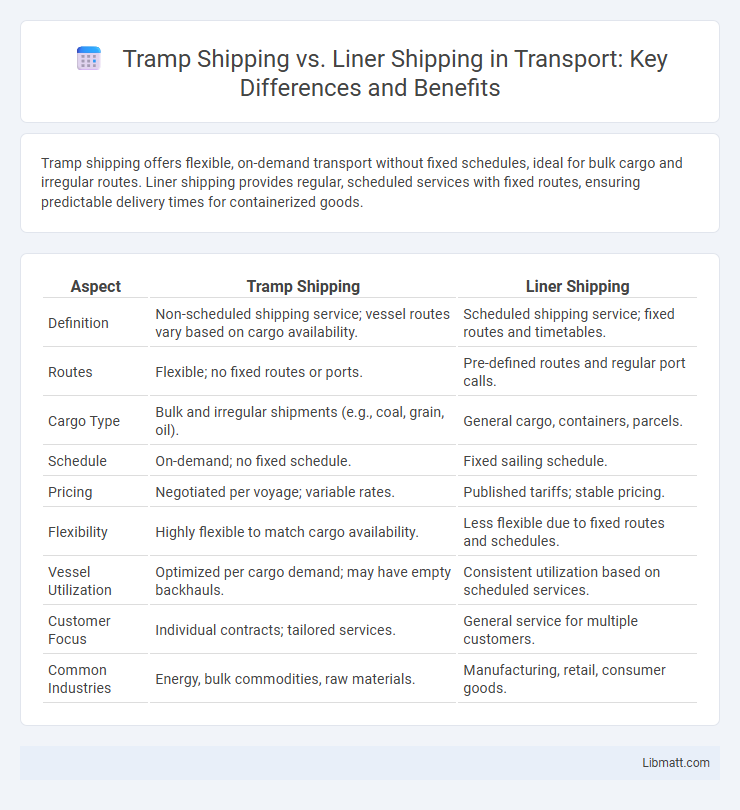Tramp shipping offers flexible, on-demand transport without fixed schedules, ideal for bulk cargo and irregular routes. Liner shipping provides regular, scheduled services with fixed routes, ensuring predictable delivery times for containerized goods.
Table of Comparison
| Aspect | Tramp Shipping | Liner Shipping |
|---|---|---|
| Definition | Non-scheduled shipping service; vessel routes vary based on cargo availability. | Scheduled shipping service; fixed routes and timetables. |
| Routes | Flexible; no fixed routes or ports. | Pre-defined routes and regular port calls. |
| Cargo Type | Bulk and irregular shipments (e.g., coal, grain, oil). | General cargo, containers, parcels. |
| Schedule | On-demand; no fixed schedule. | Fixed sailing schedule. |
| Pricing | Negotiated per voyage; variable rates. | Published tariffs; stable pricing. |
| Flexibility | Highly flexible to match cargo availability. | Less flexible due to fixed routes and schedules. |
| Vessel Utilization | Optimized per cargo demand; may have empty backhauls. | Consistent utilization based on scheduled services. |
| Customer Focus | Individual contracts; tailored services. | General service for multiple customers. |
| Common Industries | Energy, bulk commodities, raw materials. | Manufacturing, retail, consumer goods. |
Understanding Tramp Shipping
Tramp shipping operates without fixed schedules or routes, carrying cargo as it becomes available, which offers flexibility for bulk goods like coal, oil, or grain. Unlike liner shipping, which follows predetermined routes and schedules, tramp shipping adapts to market demand and can access ports less frequently served by liners. Your understanding of tramp shipping helps in selecting the right transportation mode for irregular cargo volumes or unique shipment needs.
Overview of Liner Shipping
Liner shipping operates on fixed schedules and established routes, providing regular, reliable services primarily for containerized cargo. It caters to standardized shipments with predetermined port calls, enabling efficient cargo planning and supply chain management. Major global liner companies include Maersk, MSC, and CMA CGM, which dominate container transport across key trade lanes.
Key Differences Between Tramp and Liner Shipping
Tramp shipping operates without fixed schedules or routes, offering flexible and on-demand cargo transport for bulk goods, while liner shipping follows predetermined routes and timetables, primarily serving containerized and general cargo. Tramp ships contract cargo on a voyage or time charter basis, catering to large volumes and irregular shipments, whereas liner vessels maintain frequent sailings with published tariffs for standardized, smaller shipments. Operational costs in tramp shipping vary widely due to route flexibility, contrasting with the fixed cost structures and network efficiencies typical of liner shipping services.
Cargo Types Handled by Tramp vs Liner Services
Tramp shipping primarily handles irregular cargo such as bulk commodities, raw materials, and oversized goods that require flexible routing and scheduling. Liner shipping specializes in containerized cargo, general merchandise, and standardized shipments that benefit from fixed schedules and routes. The distinct cargo types dictate the operational models, with tramp services offering customization and liners ensuring reliability and efficiency.
Operational Flexibility: Tramp vs Liner Shipping
Tramp shipping offers high operational flexibility by operating without fixed schedules or routes, allowing vessels to adapt quickly to varying cargo demands and destinations. Liner shipping follows predetermined routes and timetables, optimizing efficiency and reliability for scheduled cargo services but limiting responsiveness to sudden market changes. This distinction makes tramp shipping ideal for irregular, bulk, or non-containerized cargo, while liner shipping suits regular, containerized cargo requiring strict delivery timelines.
Route and Schedule Characteristics
Tramp shipping operates without fixed routes or schedules, offering flexible transportation tailored to cargo availability and client demands, often serving remote or irregular ports. In contrast, liner shipping follows predetermined routes and published schedules, providing consistent, reliable service on major trade lanes with frequent departures. Your choice between tramp and liner shipping depends on the need for flexible timing versus predictable, routine shipments.
Pricing Structures Compared
Tramp shipping operates with flexible pricing based on spot market conditions, cargo type, and voyage specifics, often resulting in variable rates tailored to individual contracts. In contrast, liner shipping employs fixed, published tariffs with standardized fees and schedules, promoting predictability and consistency for regular container services. This distinction in pricing structures affects cost transparency and risk management for shippers choosing between the two models.
Market Participants and Stakeholders
Tramp shipping primarily serves cargo owners, shipbrokers, and charterers involved in transporting goods on an irregular schedule to various ports based on demand, emphasizing flexibility and direct negotiations. Liner shipping involves fixed schedules and regular routes, catering to shippers, freight forwarders, and logistics companies who rely on predictable services and standardized contracts. Your decision between these two depends on whether you need customized, route-flexible solutions or consistent, timetable-driven transport.
Advantages and Disadvantages of Each Mode
Tramp shipping offers flexibility and cost-efficiency by operating without fixed schedules, making it ideal for irregular cargo and routes, but it often results in longer transit times and unpredictable arrival schedules. Liner shipping provides reliable, scheduled services with fixed routes, ensuring timely deliveries and better planning for shippers, yet it tends to be more expensive and less adaptable to fluctuating cargo volumes. The choice between tramp and liner shipping depends on shipment regularity, budget constraints, and the need for timely delivery.
Choosing the Right Shipping Method for Your Cargo
Tramp shipping offers flexible routes and schedules, ideal for irregular or bulk cargo that doesn't conform to fixed itineraries, while liner shipping provides regular, scheduled services with fixed routes perfect for containerized goods requiring timely and predictable delivery. Your choice depends on cargo type, volume, and delivery urgency, with tramp ships suited for large, bulk, or oversized items and liner services optimal for standardized shipments demanding reliability. Understanding the cost structure, transit time, and cargo specifications helps ensure you select the best shipping method to meet your logistical needs efficiently.
tramp shipping vs liner shipping Infographic

 libmatt.com
libmatt.com